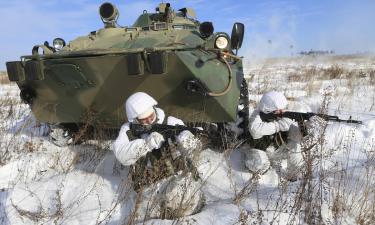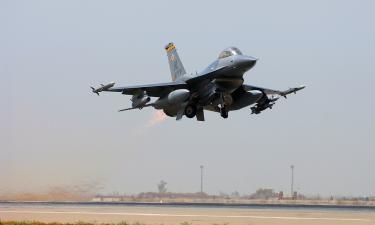People book tours to watch whales in Virginia
Watching a humpback whale rise from the murky depths of the Atlantic Ocean, a mile or two (a few kilometers) from the long wall of high rise hotels off Virginia Beach, is a strange but wonderful sensation.

The slick black giant is a wonder as it slides unseen beneath the waves only to unexpectedly rise, blow a mighty blast of misty breath, and slide back underwater to disappear again.
I have crossed the Atlantic and seen some of the Pacific, Mediterranean and Caribbean, but this is my first time seeing a whale, and I did not even have to leave my home state. I am one of 118 people aboard a lumbering 60-foot (18-meter) catamaran and now we are all looking and pointing and shouting and filming - even though the creature appears to have no interest in us.
Our guided tour aboard the double-decked Rudee Flipper cruise boat is run by the Virginia Aquarium & Marine Science Center. While they don't promise that their excursions will always find a whale, their record for this past January was 100 percent and averages 82 percent over the past two years.
But the suspense added to the interest as the passengers took seats along the outside of the cabin, and on the upper deck behind the wheelhouse. Our guide described the seabirds as people checked their cameras, scoped out the best spots along the rail and adjusted their sunglasses.
With an expert rev of the diesel engines and turn of the wheel, the crew cast off lines, and we eased past the pilings and turned under the narrow concrete bridge, scattering the partly submerged mergansers and cormorants. The fishermen and families walking the rocks of the jetty waved us on. Into the ocean, we turned north and the boat began rocking side to side in the gentle swell. We sped past the hotel-lined beach of this resort city, anxious eyes seaward looking for the hoped-for whales, or at least a dolphin or porpoise.
Past the north end of the boardwalk, where the beach gives way to dunes, the ship slowed and angled back toward the shore. Almost on cue, and to the echoing gasp of the crowd, a whale exhaled a rush of misty breath. A long ridge of blubbery black back rose above the water, rolled forward until a little knoblike point of it touched the water and disappeared, the AP reports.
A crowd of gulls darted down to the water to grab some of the bait fish brought up by the feeding whale, a juvenile humpback that lingered in the area enjoying the fish while adult whales migrated down to the warmer waters of the Caribbean to spend the winter mating.
Excited minutes passed in a general rush of the crowd to the closest side of the boat before yet again, the loud watery breath sent a vaporous column high into the air. The skitteringgulls rushed to get fish from the part of the whale sliding forward in a graceful turn as it quickly disappeared beneath murky sea yet again. It was impossible to guess where or when the whale would show next.
Sometimes long expectant minutes would pass before the whale would burst forth its steamy gasp. Other times a quick pass under water would bring it back to the top as we studied every exposed inch (centimeter) from the bulbous area in front of the blowhole to the whitish mark on the knobby ridge on its back.
Ships from the U.S Navy's Atlantic Fleet slid out to sea around us, the birds grew tired and sated and settled on the surface, a pelican came and dived down next to the whale with a great splash and then in turn was splashed as the great tonnage of animal rose above the water and turned. The water in which this 25-plus-ton behemoth fished was not much deeper than its girth, so there was no room for it to dramatically dive or rise.
We stayed close to the rail as Capt. Mark Sterling gently turned the boat from side to side to give everybody a good look. The whale would come close and raise its great bulk nearby, or then again far off. For an hour or more we remained near the whale. Our guide, Karen Burns, told us they were following federal recommendations for whale-watching. Keeping a certain distance, not moving directly at the whale and keeping the engine noise to a minimum.
During this time, people were madly taking pictures, holding their cell phones and video cameras over heads for a better view. Standing on the benches to see over people in front. Talking on their phones to friends far away to tell them about it. We shared the sense of wonder every time the whale exhaled its powerful blast and slid past. The children crying "there it is," "there it is" each time.
One of the volunteers on the trip, Joe Sloan, kept everyone entertained by sharing an interesting collection of whale relics. He displayed the baleen of the humpback, the coarse fibrous jaw in which the whale traps small fish, shrimp and krill as they spit out the many gallons of water they take in while feeding and then lick back into their huge mouths. He had a model of a sperm whale tooth like those carved by the whalers of yore into scrimshaw. He brought out a dinner plate-sized vertebrae from the spine of a whale and the hard whelk-like ear, having all of us try to guess what it might be.
Eventually the whale's breaching grew distant, our boat turned around to head back and Burns began to tell us about dolphins and porpoise. But receding behind the stern we could still make out the whale continuing its feast, marked by the blast of breath, the ripple of wave and the black, bulky ridge of its back.
Subscribe to Pravda.Ru Telegram channel, Facebook, RSS!





